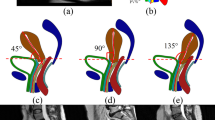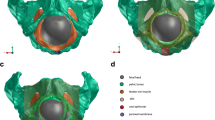Abstract
Pelvic floor dysfunction is a hidden problem with a magnitude unknown to many. Statistics show that one in every ten women will have pelvic floor dysfunction so severe that it will require surgery. Several studies have shown that pelvic floor injuries during a vaginal delivery can be considered a significant factor in the development of urinary incontinence, fecal incontinence, and pelvic organ prolapse. The objective of the present work is to contribute to the clarification of the mechanisms behind pelvic floor disorders related to a vaginal delivery. For this purpose, a numerical simulation based on the finite element method was carried out. The finite element model intends to represent the effects that the passage of a fetal head can induce on the muscles of the pelvic floor, from a mechanical point of view. The model used for the simulation represents the pelvic bones, with the attached pelvic floor muscles and the fetus. In this work, we simulated the movements of the fetus during birth, in vertex position. We simulated the engagement, descent, flexion, internal rotation, and extension of the fetal head. Results for the pelvic floor stretch values obtained during the passage of the fetus head are presented; the deformation field is also shown. The results were obtained using the finite element method and a three-dimensional computer model of the pelvic floor and fetus. The maximum deformation obtained was 0.66 for a vertical displacement of the fetal head of approximately 60 mm.





Similar content being viewed by others
References
Olsen AL, Smith VJ, Bergstrom JO, Colling JC, Clark AL (1997) Epidemiology of surgically managed pelvic organ prolapse and urinary incontinence. Obstet Gynecol 89:501–506
Kenton K, Mueller ER (2006) The global burden of female pelvic floor disorders. Br J Urol 98:1–5
Rortveit G, Hannestad Y, Daltveit AK, Hunskaar S (2001) Age- and type-dependent effects of parity on urinary incontinence. The Norwegian EPINCONT study. Obstet Gynecol 98:1004–1010
Dimpfl Th, Jaeger Ch, Mueller-Felber W, Anthuber C, Hirsch A, Brandmaier R et al (1998) Myogenic changes of the levator ani muscle in premenopausal women: the impact of vaginal delivery and age. Neurourol Urodyn 17:197–205
Gregory WT, Nygaard I (2004) Childbirth and pelvic floor disorders. Clin Obstet Gynecol 47:394–403
DeLancey John OL (1999) Structural anatomy of the posterior pelvic compartment as it relates to rectocele. Am J Obstet Gynecol 180:815–823
Papa Petros PE (2004) The female pelvic floor, function, dysfunction and management according to the integral theory. Springer, Berlin Heidelberg New York
Humphrey JD (2003) Continuum biomechanics of soft biological tissues. Proc R Soc Lond A 459:3–46
Janda S, Van der Helm FCT, Blok SB (2003) Measuring morphological parameters of the pelvic floor for finite elements modelling purposes. J Biomech 36:749–757
Aulignac D, Martins JAC, Pires EB, Mascarenhas T, Natal Jorge RM (2005) A shell finite element model of the pelvic floor muscles. Comput Methods Biomech Biomed Eng 8:339–347
Hoyte L, Jakab M, Warfield SK, Shott S, Flesh G, Fielding JR (2004) Levator ani thickness variations in symptomatic and asymptomatic women using magnetic resonance-based 3-dimensional color mapping. Am J Obstet Gynecol 191:856–861
Boukerrou M, Lambaudie E, Dubois P, Cosson M (2004) Etude préliminaire d’un modèle mécanique de cavité vaginale, ITBM-RBM 25:3–14
Lien KC, Mooney B, DeLancey John OL, Ashton-Miller JA (2004) Levator ani muscle stretch induced by simulated vaginal birth. Obstet Gynecol 103:31–40
Lien KC, Morgan DM, DeLancey John OL, Ashton-Miller JA (2005) Pudendal nerve stretch during vaginal birth: a 3D computer simulation. Am J Obstet Gynecol 192:1669–1676
Fung YC, Tong P (2001) Classic and computational solid mechanics. World Scientific, Singapore
Zienkiewcz OC, Taylor RL (2005) The finite element method for solid and structural mechanics, 6th edn. Elsevier, Amsterdam
Llewellyn-Jones D (2004) Fundamentals of obstetrics and gynaecology. Elsevier, Amsterdam
Martins JAC, Pires EB, Salvado R, Dinis PB (1998) A numerical model of passive and active behaviour of skeletal muscles. Comput Methods Appl Mech Eng 151:419–433
Humphrey JD, Yin FCP (1987) On constitutive relations and finite deformations of passive cardiac tissue: a pseudostrain-energy function. J Biomech Eng 109:298–304
Brooks SV, Zerba E, Faulkner JÁ (1995) Injury to muscle fibres after single stretches of passive and maximally stimulated muscles in mice. J Physiol 488:459–469
DeCherney AH, Nathan L (2003) Current obstetric and gynecologic diagnosis and treatment. Lange medical books, 9th edn. McGraw-Hill, New York
Acknowledgment
Funding by Ministério da Ciência, Inovação e do Ensino Superior, FCT, Portugal, under grants POSI/SFRH/BD/13013/2003, as well as the funding by FEDER under grants POCTI/ESP/46835/2002 are gratefully acknowledged.
Author information
Authors and Affiliations
Corresponding author
Rights and permissions
About this article
Cite this article
Parente, M.P.L., Jorge, R.M.N., Mascarenhas, T. et al. Deformation of the pelvic floor muscles during a vaginal delivery. Int Urogynecol J 19, 65–71 (2008). https://doi.org/10.1007/s00192-007-0388-7
Received:
Accepted:
Published:
Issue Date:
DOI: https://doi.org/10.1007/s00192-007-0388-7




